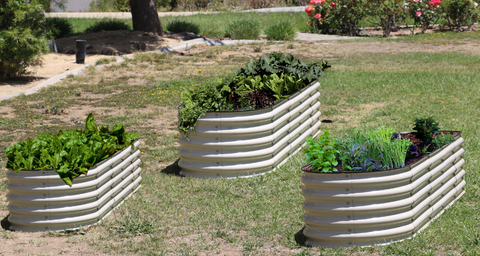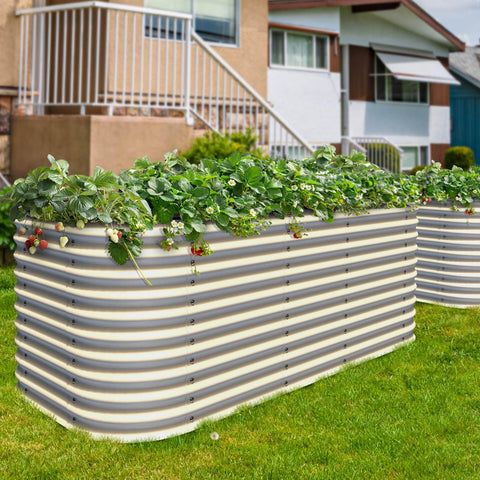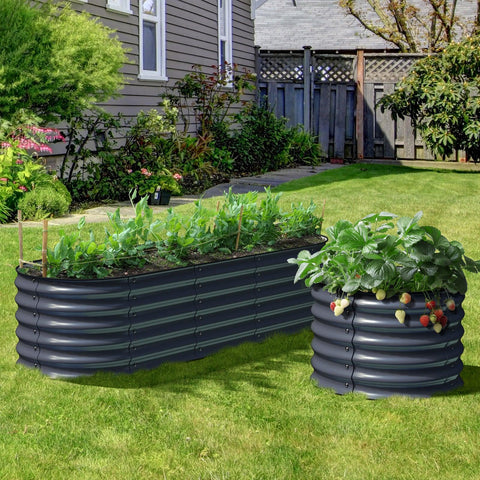Knowledge from Olle Garden Bed: What To Plant In January
The garden may be dormant in a cold, cool January, but there are still many things to do! How about starting early in the growing season? Read here are some things that you should know when It comes to Olle Garden Beds!
You may wonder if it is a good idea to plant anything in the garden in the middle of winter, but you will be surprised how many plants will thrive despite the temperature drop! If you have no idea, here are some of the many plants you can plant in January:

Crops planted in January
Pepper: As long as there is enough cold protection, pepper will thrive in cold weather like January. Try planting two or three seeds per pot, then adding organic compost. Cover your depth with vermiculite to complete. If you have a heated breeder, use it to speed up germination. The seedlings should germinate in about a week
Eggplant: Eggplant is one of the easiest vegetables to grow in cold months. It usually thrives on sunny days, because it is a slow starter and needs continuous sunshine, but with patience, it is also likely to grow in January. Look for bright spots indoors or in heated greenhouses, because seedlings must be kept away from frost. Plant several seeds in each pot and enrich the soil with organic fertilizer. Keep the temperature at 21-27 ° C (70-80 ° F), and the seeds will germinate in a week or more. The varieties suitable for planting are long purple, cabery and black beauty.
Basil: One of the most popular herbs is also the easiest to grow. Basil thrives in sunny places, but if taken care of properly, it will also grow in January. This herb thrives at temperatures ranging from 15C to 25 ° C. At the ideal temperature, the seeds will germinate between 14 and 21 days. Because basil doesn't grow too big, you can plant it in a pot. After ripening, trim regularly to maintain the flavor of herbs.
Peas: Many varieties of peas performed well in January, especially snow peas, sweet beans and English peas. Peas are very cold resistant and can withstand cold temperatures. You can plant peas outdoors or indoors in well drained soil pots. Peas can increase nitrogen in the soil, so it is a good vegetable to plant together with sweet corn before or after winter. Peas are also ideal for growing with celery, cucumbers, potatoes and spinach.
Rhubarb: A warm windowsill can provide enough heat to germinate rhubarb seeds. Plant in well drained soil pots and allow it to germinate for about 20 to 30 days. Rhubarb needs its sweet time to sprout, but once it does, it will be ready to harvest in a few weeks. We suggest planting the permanent variety of Grasskin from the seeds in January.
Potatoes: Potatoes and other root crops can surprisingly tolerate cold weather. In other words, it is better to plant this crop in potato bags to avoid freezing from the ground. Many potato varieties will grow well in winter, but Charlotte is one of the most resilient varieties.
Onions: Onions and other bulbs are crucial for indoor growth even in January. Because they grow slowly, you need to give the bulbs as much time as possible to get bigger. Sow the seeds in the growth tray and place them in a warm, sunny place. Once the seedlings have grown, you can move the bulbs to a cooler place as long as the risk of frost has passed.

Fruit growth in January
Raspberry: We consider planting crops in spring, so that the garden will bear fruit in summer, but winter may be a good time to plant summer berries such as raspberries. As long as the soil is not frozen or soaked; You can plant this berry in the cold season from November to March. This strategy is most suitable for container gardening. Choose a sunny place and plant raspberries in well drained soil.
Blueberry: The substitute for raspberry is blueberry. This berry can be planted in flower pots in winter, as long as the ground is not frozen or soaked. Like raspberries, blueberries are grown in a pot of slightly acidic soil from November to March. If you have a greenhouse, these should be set in a warm and bright place. You can plant blueberries with different crops to extend the growing season, such as thyme, cranberries, and plants that thrive in slightly acidic soil.
Grapes: Grapes are best planted with bare roots in the dormant season from January to February. The important thing is to install a trellis so that the vines can climb up. Grapevine can grow rapidly and massively, so the trellis should be durable. Regularly trim plants, trim excess roots or remove broken or browning branches or leaves. To increase the chances of success, we recommend planting American varieties because they are more resistant to mold and root lice.
Strawberry: Although strawberry is best planted in spring, it thrives in mild weather and can withstand freezing temperatures! This plant is also an ideal choice for container gardens because it will not grow too large. Like most berries, strawberries thrive when pruned regularly. No need to water regularly; When necessary, to avoid root disease.
Sweet cherries: Cherry trees can withstand extreme temperatures, except the extreme heat of the desert. Sweet cherries will thrive in cool temperatures and like bright lights, so they should be planted where the sun shines in the morning and shaded in the afternoon. Some birds will actively search for cherry trees, so we suggest installing nets for protection.
Growth of flowering plants in January
Lonicera: Add a touch of beautiful color to your winter garden with the beautiful Amaryllis. This flowering bulb thrives in good potted soil and bright indirect light. It doesn't need too much water. It starts to blossom six to eight weeks after planting.
Hellebor: The sea lizard is a good flowering plant in January. As long as the ground is not frozen, Hellebor can be planted underground. Otherwise, the plant will grow in the flowerpot. Hellebore will thrive in a semi cool place, where there is bright light, but the heat is not so strong. Use moist, fertile and well drained soil. Hellebore has many varieties, so please plant different colors to create a lush and colorful winter garden.
Pelargonium: Even in winter, geranium is very easy to grow, but there is a process to follow. Because of its abundant genetics, you must store plants in a dormant state. Put the plants in kraft paper bags or cardboard boxes and check them every four weeks until the stems shrink. Soak the root ball in a bucket of water for at least one hour, let it dry, and then put it back into the container. After a few weeks, you can plant it outdoors.
Sweet pea: This annual flowering plant has many colors, including magenta, purple and white. In order to successfully plant sweet peas, please plant them early in the season. Sweet peas are hardy plants that can be sown at the end of winter. As long as the soil is dry, not frozen or soaked, it will grow. Use decomposed dung or compost to improve the soil, because sweet peas like rich, moist and well drained soil.

Plant plants together with ecological gardeners in January
As you can see, even in January, various plants will thrive. Start your winter garden today. In early spring, your garden will be full of vitality!
